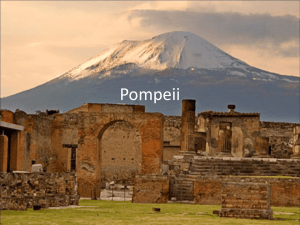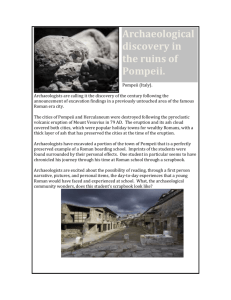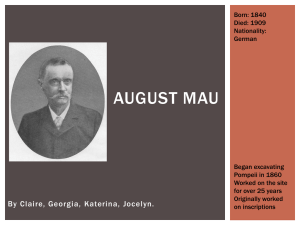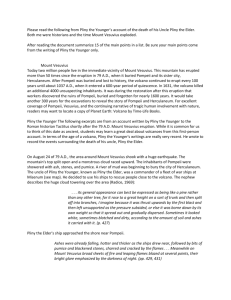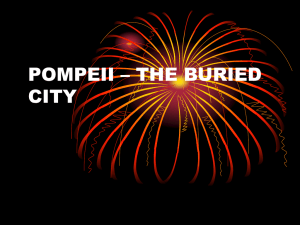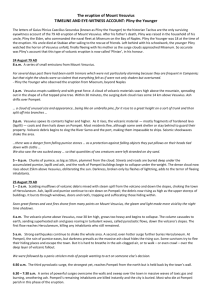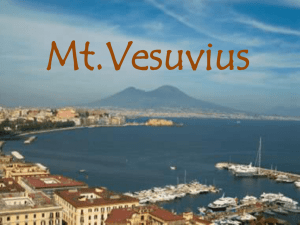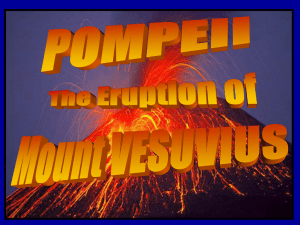Pompeii Travel back in time to Ancient Rome to find out what
advertisement
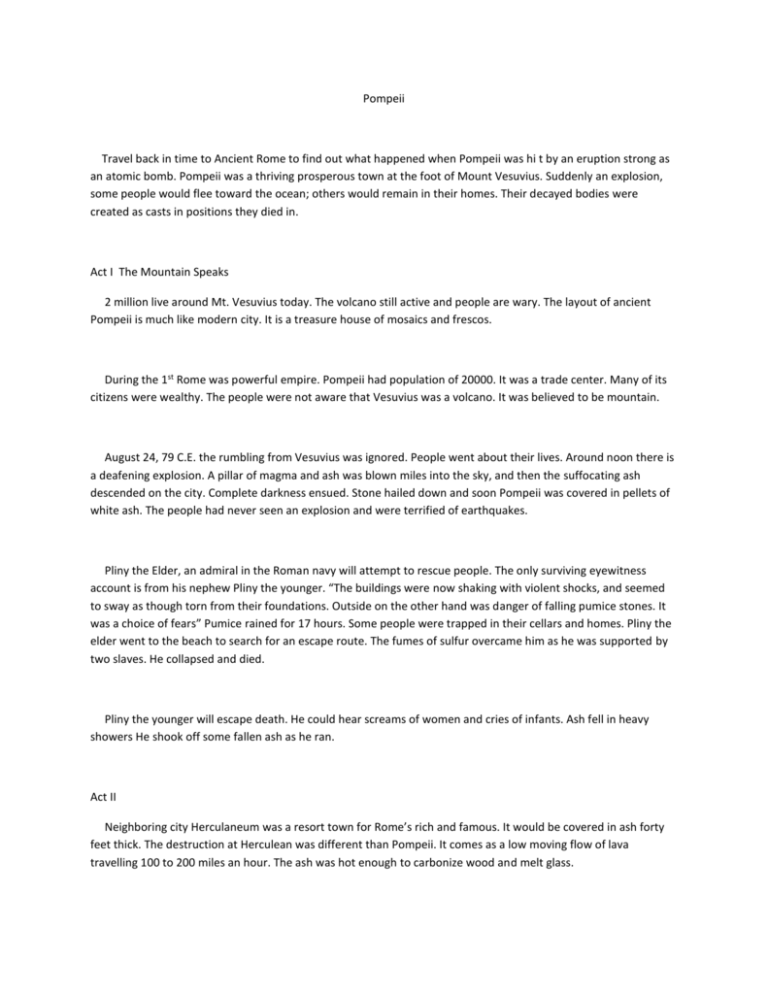
Pompeii Travel back in time to Ancient Rome to find out what happened when Pompeii was hi t by an eruption strong as an atomic bomb. Pompeii was a thriving prosperous town at the foot of Mount Vesuvius. Suddenly an explosion, some people would flee toward the ocean; others would remain in their homes. Their decayed bodies were created as casts in positions they died in. Act I The Mountain Speaks 2 million live around Mt. Vesuvius today. The volcano still active and people are wary. The layout of ancient Pompeii is much like modern city. It is a treasure house of mosaics and frescos. During the 1st Rome was powerful empire. Pompeii had population of 20000. It was a trade center. Many of its citizens were wealthy. The people were not aware that Vesuvius was a volcano. It was believed to be mountain. August 24, 79 C.E. the rumbling from Vesuvius was ignored. People went about their lives. Around noon there is a deafening explosion. A pillar of magma and ash was blown miles into the sky, and then the suffocating ash descended on the city. Complete darkness ensued. Stone hailed down and soon Pompeii was covered in pellets of white ash. The people had never seen an explosion and were terrified of earthquakes. Pliny the Elder, an admiral in the Roman navy will attempt to rescue people. The only surviving eyewitness account is from his nephew Pliny the younger. “The buildings were now shaking with violent shocks, and seemed to sway as though torn from their foundations. Outside on the other hand was danger of falling pumice stones. It was a choice of fears” Pumice rained for 17 hours. Some people were trapped in their cellars and homes. Pliny the elder went to the beach to search for an escape route. The fumes of sulfur overcame him as he was supported by two slaves. He collapsed and died. Pliny the younger will escape death. He could hear screams of women and cries of infants. Ash fell in heavy showers He shook off some fallen ash as he ran. Act II Neighboring city Herculaneum was a resort town for Rome’s rich and famous. It would be covered in ash forty feet thick. The destruction at Herculean was different than Pompeii. It comes as a low moving flow of lava travelling 100 to 200 miles an hour. The ash was hot enough to carbonize wood and melt glass. Act II At public baths, a marble vase stands where it originally was, but it had been thrown against the opposite wall of the bathroom originally. What happened to the people? No skeletal remains had been found. Recent excavations at seashore reveals up to a hundred victims that are very well preserved. Romans cremated their dead, so remains give a picture of Roman life. A Roman soldier was found with his sword, money belt and coins. One chamber contained a family of 12 members. A woman of 14 is shown holding a baby to her chest. The baby was an aristocratic baby with and pearl earrings. The girl was a poor slave girl with signs of hard work in her body and teeth. The Gleaming white teeth of the wealthy showed they were healthy. There are moving examples of body cavities left in the ash. Archaeologists made casts from the molds created in ash. All slaves wore belt with name of their owner. Act III — Act III compares Mount St. Helens and Vesuvius. Vesuvius was three times St. Helens. Grass and vines over grew city. 1500 years later Herculean is found in 1709 two monks drilling a well hit the marble floor of a theatre. Pompeii was also discovered by accident by digging a canal. Treasure hunters led to it being examined. Kings plundered the area sinking shafts and tunnels into the city. In 1861 orderly excavation begins and continues today. Computers are used to rebuild ancient Pompeii. Three-D buildings are constructed. Pompeii puts modern viewers into the Roman world. You can go into the homes. Complete dwellings can be explored. Plumbing lays bare. Piping systems are sophisticated. Even a loaf of bread is preserved. Wall of bread is preserved. Wall paintings and mosaic show great artistry, instruments of ivory and gold jewelry. Pliny the Younger described life in a villa, the dining, and the gardens. Only a small fraction lived in wealth. There was essentially no middle class. The home décor was Greek in origin. A mosaic of Alexander the Great is a copy of one in Greece. The Romans were overwhelmed by Greek culture. A mosaic of street musicians has the artist’s signature. Themes from Greek literature were popular. Many painters may have been Greek slaves. The most famous artifact recovered from Pompeii are the bronze wrestlers from in garden in Herculean. Prior to contact with Greek’s Romans were not artists. Architecture is where Romans make their mark. The arch and concrete are major contributions. The Romans reinforce their power with massive civil engineering skills. They created Indoor baths that had a glass window. An anonymous Roman invented glass window. It spreads through Rome and leads to invention to the greenhouse. Act IV The details of male and female relationships are revealed by Pompeii. Women did not have same rights as men. They could hold office or vote. The Matron exercised power within the home, at dinner parties and over the family in home. An image from Pompeii shows a woman with a stylus and tablet. This shows she is literate and educated. Julia Felix was a wealthy and independent woman. Most women in Rome lived a subdued lifestyle within the home. Her job was Running the home and managing the slaves. A Roman woman did not want a career. One career flourished in Pompeii. In the very center of the city is the local brothel. It contains stone beds which would be covered in blankets. The painted walls reveal the activities that would take place in the brothel. Life was shard for the prostitutes; they would be abused and underfed. Sexual imagery extended to the homes of the wealthy. Explicit scenes were depicted on the walls and homes would have wind chimes with exaggerated phalluses. The purpose of the images is for the home’s fertility and to ensure luck. Walls in Pompeii would be decorated with phalluses, 18th and 19th centuries excavators destroyed these because they considered them obscene. Act V The Romans viewed life and death was different than today. Rome was built on slave labor. Slaves were absorbed as the spoils of war. Slaves came from Egypt, Greece and Tunisia. The Romans would conquer a region, then kill the men and sell women and children as slaves. There was a thriving slave trade. An aristocratic home would have fifty slaves. Slave, convicted criminal and prisoners of war were forced to compete in the gladiator games. Pompeii arena held 20, 000. One of the most popular featured a heavily armored gladiator wearing a bronze helmet and armed with a sword fought an almost nude fighter armed with net and spear. The lack of a middle class required a wealthy Roman to need a slave for tailoring, dressmaking or shoemaking. Civic responsibilities were taken seriously. In Roman law the father had complete legal power. A father could kill his children A tale exists were a consul orders his son not to press an attack. The sons attacks and achieves a great victory. The consul puts his son to death for disobeying orders. The Romans did not hold any life but their own as sacred. Romans saw death all the time. The religion did not have a text or clear moral guide. Roman values were different form Judeo – Christian beliefs spreading at the time. Religion was a ritual that people exercised however they wished. Society was freer than today. Since 79 C.E. Mount Vesuvius has erupted more seventy times. The 1944 eruption took place as Italy reeled from world war two. On this occasion the Vesuvius spewed molten lava that moved twelve feet per minute. The worse eruption was in 1631 when 18,000 people died. The people of Pompeii are just beyond our grasp. Pompeii makes us touch our own feelings about life and death. In one dreadful night a volcano destroy an entire community and the people are still a mystery.

